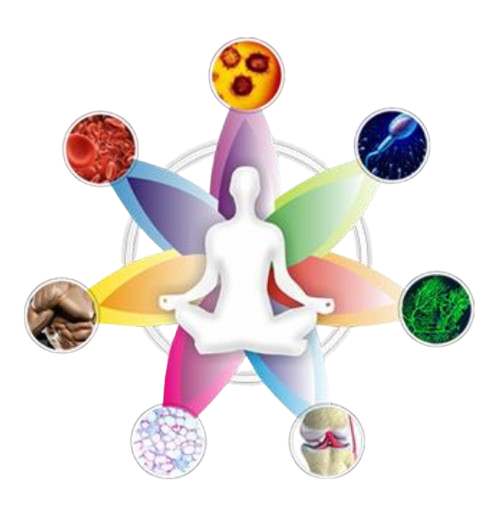Ayurved & You
“यथा वपण्डे तथा ब्रह्माण्डे, यथा ब्रह्माण्डे तथा वपण्डे” – यजुर्वेद
Meaning – As in the body, so in the Universe. As in the Universe, so in the body.
What is Ayurveda?
Ayurveda is an ancient healing system that focuses on the balance of the body, mind, and spirit. It views humans as interconnected with nature, with health being a dynamic state of harmony between the body's internal systems and external forces like the environment.

Doshas
Vata, Pitta, and Kapha - which govern our physical, emotional, and mental traits. Ayurveda emphasizes personalized care, prevention, and practices like proper diet, yoga, and herbal treatments to maintain balance. By aligning with our unique constitution (Prakriti) and the natural world, Ayurveda aims for holistic well-being, where health is defined by vitality, harmony, and peace.
Dosha and the Human Body:
Each person has a unique combination of these Doshas, with one or two typically dominant. This balance determines a person's Prakriti (constitution), which influences physical appearance, emotional traits, and susceptibility to illness.

Vata
People with this pravruti end to be lean, energetic, and creative
Pitta
People with this pravruti are typically medium-built, focused, and driven
Kapha
People with this pravruti are sturdy, calm, and emotionally steady
Ayurveda emphasizes maintaining balance in the Doshas through diet, lifestyle, and treatments. When the Doshas are balanced, the body and mind function harmoniously, leading to optimal health.

Saptadhatu
In Ayurveda, the concept of Saptadhatu (literally "seven tissues") refers to the seven fundamental tissues or bio-substances that form the structure and function of the human body. These tissues are essential for maintaining the body’s strength, vitality, and overall health. Each of the Saptadhatus plays a key role in the body’s metabolism, nourishment, and healing. The health of these tissues depends on the proper digestion and absorption of nutrients, as well as the balance of the body's Doshas (Vata, Pitta, and Kapha).
The Seven Dhatus (Tissues) in Ayurveda:
Rasa (Plasma or Lymph)
Rasa is the first tissue formed after digestion and represents the fluid that nourishes the body. It is derived from food and liquids, and its primary function is to nourish and hydrate the body.
Rakta (Blood)
Rakta refers to the blood, which is created from Rasa and is responsible for supplying oxygen and nutrients to the tissues. It also governs the body's color, warmth, and vitality.
Mamsa (Muscle Tissue)
Mamsa refers to muscle tissue and is responsible for strength, movement, and structural support of the body.
Medas (Fat Tissue)
Medas refers to fat or adipose tissue, which plays a role in energy storage, insulation, and lubrication.
Asthi (Bone Tissue)
Asthi refers to the bones and skeletal structure of the body. It provides support, protection, and stability.
Majja (Bone Marrow and Nervous Tissue)
Majja refers to the marrow inside the bones and the nervous system. It is the tissue responsible for creating vital energy and nervous function.
Shukra (Reproductive Tissue)
Shukra refers to the reproductive tissues and the essence of vitality. It is the final Dhatu and is involved in procreation and the transmission of life force (Ojas).
The Flow of Dhatus:
The formation of the seven Dhatus follows a sequence:
• After food is consumed, it is first transformed into Rasa (plasma), which nourishes the tissues.
• Rasa is then converted into Rakta (blood), which carries oxygen and nutrients to the body.
• The next tissues, Mamsa (muscles), Medas (fat), and Asthi (bones), are created sequentially, each tissue serving as nourishment for the next.
• Finally, Majja (bone marrow) and Shukra (reproductive tissue) represent the culmination of the body's nourishment and vitality.
The Importance of Saptadhatu:
The Saptadhatus are interconnected and each one depends on the nourishment provided by the previous tissue. Maintaining the balance and health of these seven tissues is essential for overall well-being. When the tissues are strong and well-nourished, the body functions optimally, energy levels remain high, and a person experiences vitality, mental clarity, and physical strength.

Trimala
Mala refers to the waste products or by-products of the body's metabolic processes. These are the substances that are eliminated from the body after the nutrients from food and other elements have been absorbed and used. Mala plays an important role in maintaining the body's balance and health.
There are three primary types of Mala:
1. Purisha (Feces) – The waste formed after digestion of food, primarily consisting of undigested and unabsorbed matter.
2. Mutra (Urine) – The liquid waste produced by the kidneys after filtering blood to remove toxins and excess substances.
3. Sweda (Sweat) – The waste eliminated through the skin, which helps regulate body temperature and remove excess salts and toxins.
